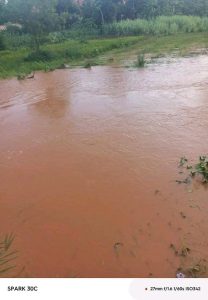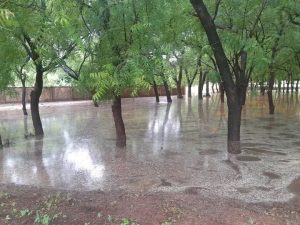By Rasheedat Abidiesin

On a fateful Wednesday afternoon in July 2025, the droplets of water are still descending on the earth. Zainu Abiden’s patience was pushed to the brink after a heavy downpour saw him and his other colleagues sheltered in one of the classes at the Faculty of Engineering and Environmental Science (FEES), in Usmanu Danfodiyo University, Sokoto (UDUS), for more than one hour.
The aftermath of the heavy rain turned UDUS communities into a pool of water, making it difficult for students to navigate the waterway while getting back to their various destinations. But Abideen forced his way back to his hostel at Jubril Aminu, one of the hostels under UDUS management.
When Abideen and his classmates got to an area at the mini-market inside the school campus, their journey became challenging. They paused to find an alternative route to boycott the heavy stagnant water that marked the mini-market. With no alternative, the 100-level students forced their passage inside the stagnant water after failing to find another route.
“The downpour starts around 1 p.m. We are inside the class and about to start a lecture around that time. The rain became so heavy and lasted for more than an hour,” he began
“We can no longer wait to head back to the hostel after the rain has stopped. But we meet a big waterfall when we reach the school mini-market. We have no choice but to go through it when we can’t see another way.”

Waterlog At UDUS Law Village—A Case Too Many
The journey from Benji to UDUS Faculty of Law takes nothing more than ten minutes on foot. For Akorede Saoban, a 400-level Law student, that few minutes of trekking turned to hours after he was denied a passage through Law Village—a route that led the faculty to his hostel. Why? Because he could not proceed to his hostel after the heavy downpour on Wednesday afternoon.
As a student whom appearing in corporate dress has become an obligatory culture in his faculty, his condition became more unbearable when he started feeling the unforgivable heat immediately after the rainfall. Therefore, he must go back to his hostel in a bid to change to another cloth.
“We can’t go back to our hostel due to the heavy rain. So when the rain stopped and we started feeling heat, we decided to go home. But we saw that we couldn’t pass the route we do pass when coming or going to the faculty.”
He explained that they did not sense the danger until they attempted to enter the water. Just like other people, Saoban was denied access from passing the usual route to his hostel that fateful day. The concern as relates to his expensive shoes that had earlier dived into the stagnant water is now ringing bells in his ears while speaking with Digest Press .
“We had to make a U- turn and pass the road down to our hostel. Although the road is manageable during passage, it also fill with water.”
In a sober tone, Saoban expressed his frustration due to the incident, especially when his N25,000 shoes almost got damaged, saying “I am still sundrying the shoes since the heavy downpour.”
Saoboan further mentioned that the major reason that accounted for the inflow of water around the school campus that day was inadequate drainage system
The plights of UDUS students reflected the general phenomenon battling Nigeria due to poor infrastructural facilities, as the problem of poor drainage is not peculiar to Law Village. Other areas around the university also suffered the same fate.
One could easily tell that inadequate provision of drainage systems in the school communities is responsible for the irregular flow of water.
For example, Benji—a neighborhood that shelters on tens of hectares of land, settled without a proper drainage system that allows water to flow freely whenever there is a downpour. For Jatau Bridge—an overpass that leads Jubril Aminu hostel to the school, the overflow nearly equals the height of the bridge, with farmlands under and around the bridge being flooded.
More Students Hold Back in Woes
Zainab, a 300-level student of Political Science, also attested to the fact that the poor drainage system is the major driver of the stagnant water around the school premises, further compounding the struggle of students.
In her words “We were about to leave for another lecture at the Faculty of Social Sciences when the rain started. We just finished our lecture at one of the classes at the Faculty of Art. We have to wait until the rain stops and when it stops, we can’t proceed to our destination again.”
When Zainab and her colleagues noticed the situation was not improving after waiting for an extended time, the students summoned their courage to navigate the water, with their dresses being soaked with water. During an interview, Zainab recounted a disturbing incident where a car struggled with the irregular water flow.
“There’s no proper drainage and gutters in our school. I think that is the main cause of the issue.’’
For Adedamola Kudroh, another student residing in Benji, her ordeal while passing the Benji-Mini Market’s route extended beyond physical inconvenience. As the sand became slippery, she was compelled to come down on a bike and walk inside the flowing water despite paying for the full fare. “The sand is slippery. I can’t risk my life, I had to drop and use my legs to trek back to my hostel.”
Effects of Poor Drainage System
The flood incident has become a major humanitarian crisis across Nigeria. Over 1.8 million individuals have been impacted by relentless rains, leading to widespread displacement, loss of lives and destruction of homes and livelihoods. Houses, farmlands and critical infrastructure have been devastated, with 98,242 homes being affected.
In 2024, over five million people were affected due to flooding in Nigeria. This was disclosed by the Director General of the National Emergency Management Agency (NEMA), Mrs. Zubaida Umar, stating that the 2024 incident resulted in the loss of 1,237 lives and widespread destruction across 35 states of the country.
The report further added that the 2024 floods led to the displacement of over 1.2 million persons, with the destruction of 115,172 houses and 1.4 million hectares of farmland across 401 Local Government Areas
Therefore, NEMA has recently identified 12 states (including Sokoto) and 43 local governments in Nigeria being prone to high risk of flooding amidst the 2025 rainy season. Another 13 states fall within the low- risk category. Poor drainage system was identified among the major reasons that caused the devastating flood disaster while suggesting improvement of drainage system in those areas.
In 2024, the Displacement Tracking Matrix (DTM), in collaboration NEMA, Sokoto State Emergency Management Agency (SEMA), and the Nigeria Red Cross Society (NRCS), identified 81 locations in Sokoto state which were impacted by floods, or received internally displaced persons (IDPs) due to the flooding.
All over the 22 local government areas of Sokoto, which were assessed, the joint assessment identified 41,792 individuals who were affected by floods.The affected population included 26,681 displaced individuals.
To wit; recall that the 2025 flood incident that unfolded in Mokwa, Niger state, claimed nothing less than 100 lives, while displacing 1,005 people, leaving counts of people injured, as others went missing.
